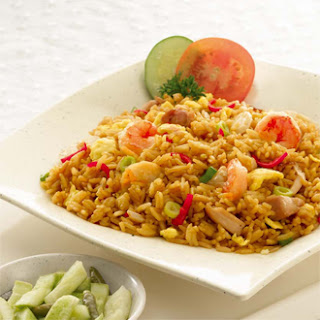Gudeg is a traditional food from Yogyakarta and Central Java, Indonesia which is made from young Nangka (jack fruit) boiled for several hours with palm sugar, and coconut milk. Additional spices include garlic, shallot, candlenut, coriander seed, galangal, bay leaves, and teak leaves, the latter giving a reddish brown color to the dish. It is also called Green Jack Fruit Sweet Stew.
Gudeg is served with white rice, chicken, hard-boiled egg, tofu and/or tempe, and a stew made of crisp beef skins (sambal goreng krecek).
There are several types of gudeg; dry, wet, Yogyakarta style, Solo style and East-Javanese style. Dry gudeg has only a bit of coconut milk and thus has little sauce. Wet gudeg includes more coconut milk. The most common gudeg came from Yogyakarta, and usually sweeter, more dry and reddish in color because the addition of teak leaves. The Solo gudeg from the city of Surakarta is more watery and soupy with lots of coconut milk and whitish in color because teak leaves is absent. The East-Javanese style gudeg employs a spicier and hotter taste, compared to the Yogyakarta-style gudeg, which is sweeter. Gudeg is traditionally associated with Yogyakarta, and Yogyakarta often nicknamed as "Kota Gudeg" (city of gudeg). The center of Yogyakarta gudeg restaurants are in Wijilan area, east side of Yogyakarta Kraton (Sultans' palace).






















